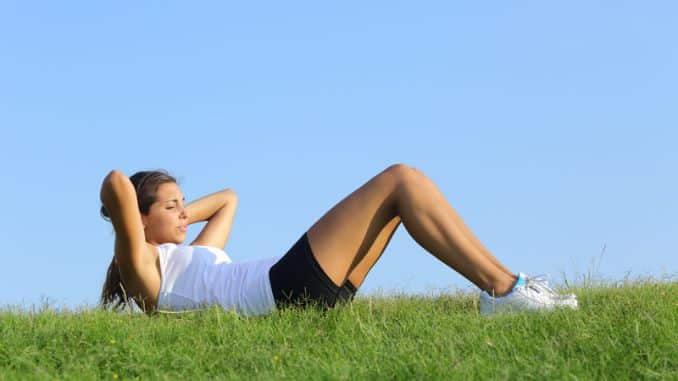“The more you move, the stronger your heart becomes.” With the advent of technology and social media, the rise of sedentary lifestyles has become a high price we must pay. People tend to become lenient in caring for their health. Most people tend to order online rather than go out and walk briskly to buy food. It now takes a lot of courage to go out and exercise. But we must remember that exercise is one of the most effective ways to improve your overall health, which includes improving your heart rate and blood pressure and helping reduce the risk of various diseases, including cardiovascular disease. Regular exercise can also aid in weight management.
Workout Routines to Improve Your Heart Rate
One of the best ways to keep your heart healthy is by improving your heart rate through a regular workout routine. Aim to get at least 30 minutes of moderate-intensity exercise most days a week. Exercise helps to strengthen your heart muscle and improve blood flow throughout your body. Check out these workout routines to help improve your heart rate.
Warm-Ups:
Before engaging in any physical activity, it's essential to perform warm-up exercises. This boosts your heart rate and makes your muscles more flexible, which benefits you by helping you avoid injury.
1. Shoulder Rolls
Begin in an upright standing position with your feet slightly wider than shoulder-width apart, maintaining good alignment with your head, shoulders, hips, and legs. Engage your core, lift your shoulders upward, then roll them back until you feel resistance in your shoulder blades. Relax and lower your shoulders to the starting position. Repeat the movement. Start with 1 set of 5 repetitions, alternating directions.
 |
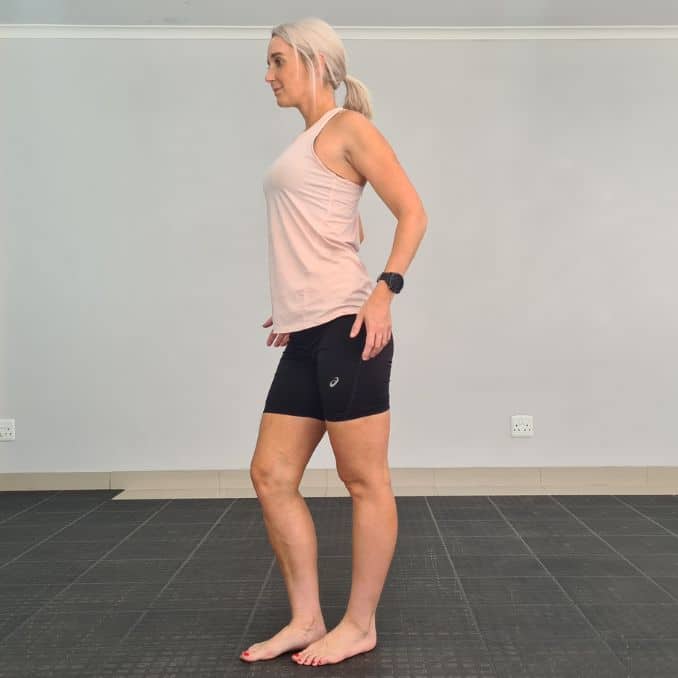 |
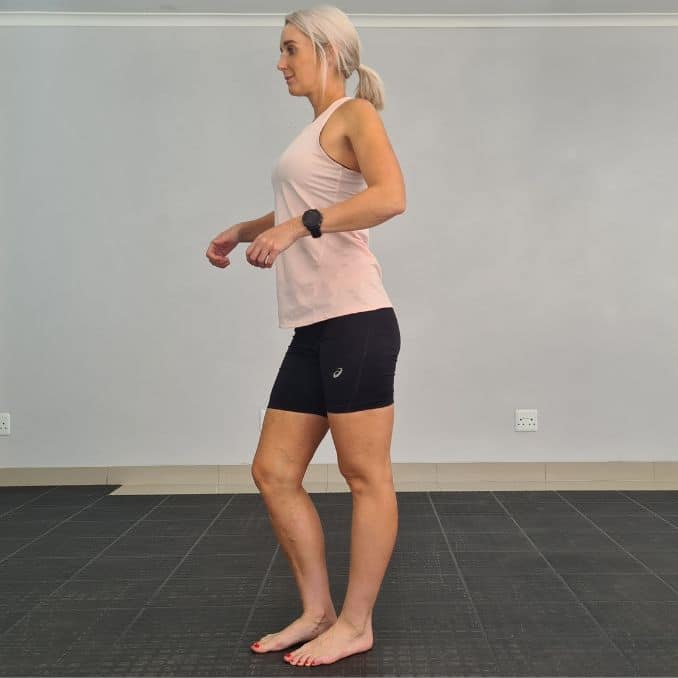 |
Shoulder Rolls
2. Standing Twist
Begin in an upright standing position with your feet slightly wider than shoulder-width apart, maintaining good alignment with your head, shoulders, hips, and legs. Straighten your arms in front of your body at chest height with your palms pressed together. Engage your core and twist your upper body to one side, keeping your hips locked in the forward position as you open one arm out to the side. Return to the starting position and repeat the movement on the opposite side. Start with 10 repetitions in each direction.
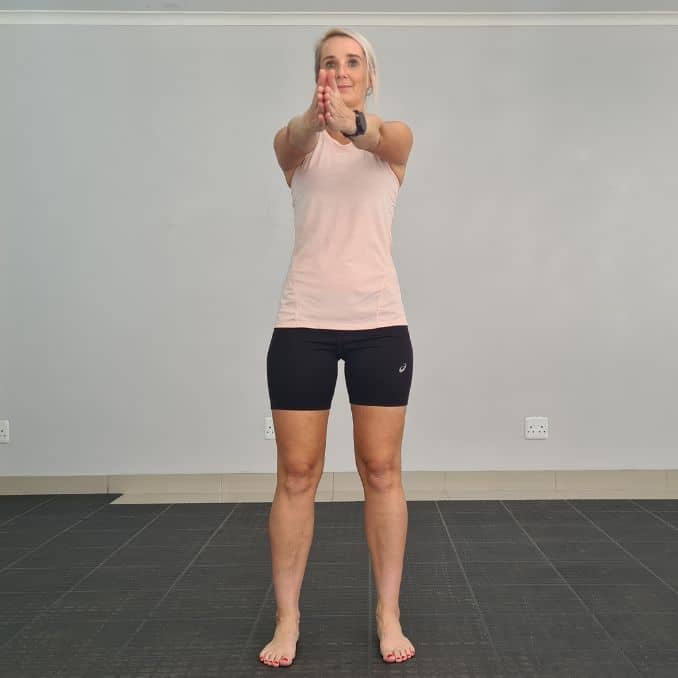 |
 |
Standing Twist
3. Squats
Begin in an upright standing position with your feet slightly wider than hip-width apart, maintaining good alignment with your head, shoulders, hips, and legs. Place your hands on your hips. Tighten your abdominal muscles. Bend your knees and hinge through your hips to lower your seat into a squat position. Keep your knees behind your toes. Raise back to an upright standing position, squeezing your glutes at the top. Repeat the movement. Start with 1 set of 10 repetitions.
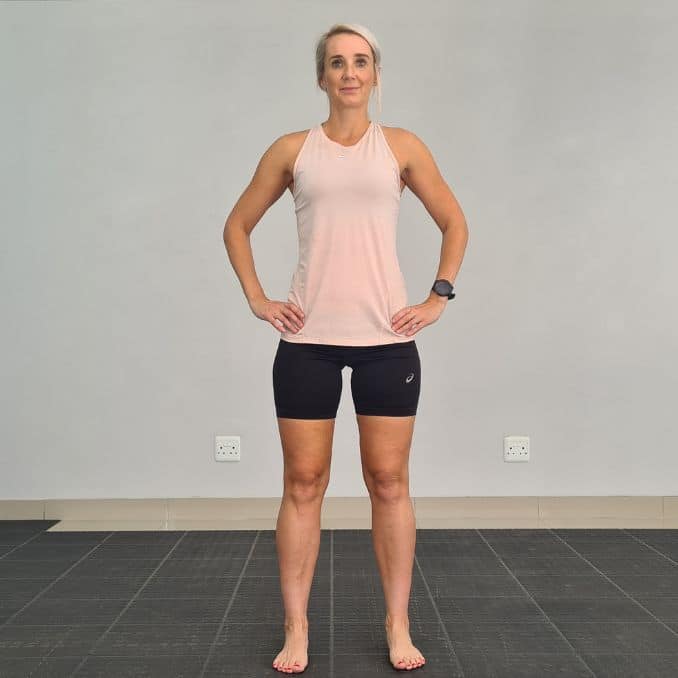 |
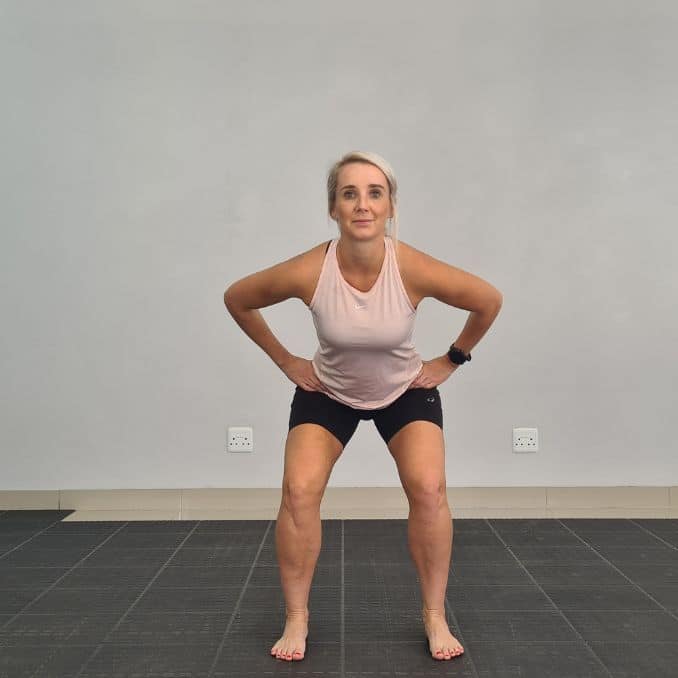 |
Shallow Squats
4. Lateral Lunges
Begin in an upright standing position with your feet wider than shoulder-width apart, maintaining good alignment in your upper body. Place your hands on your hips and tighten your core. Bend your knee to shift your body weight to one side while extending your opposite leg. Return to the starting position and repeat the movement on the opposite side.
 |
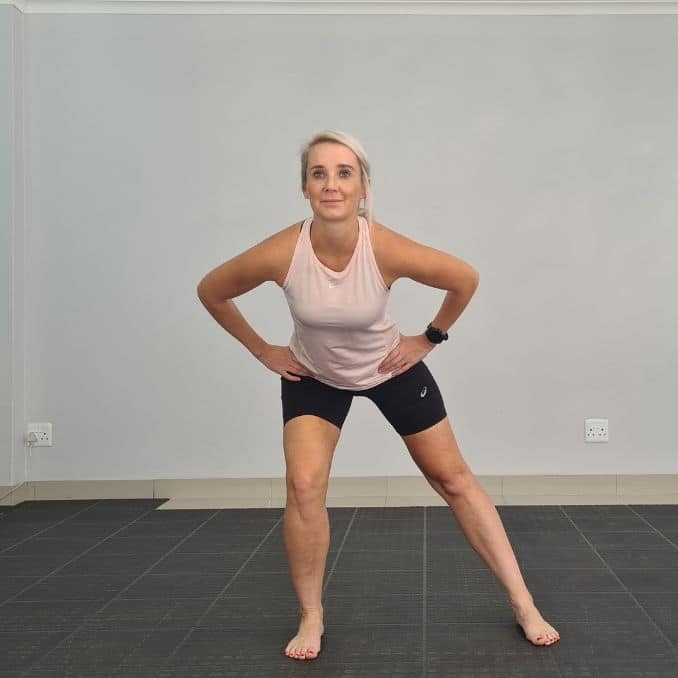 |
Lateral Lunges
Routines:
Exercise routines were created to help you reach your fitness goals, and if you follow them diligently, they are a great way to stay fit and healthy. Routines can help you look and feel your best, so make them part of your healthy lifestyle.
1. Lateral Hops
Begin in an upright standing position with your feet shoulder-width apart, maintaining good alignment with your head, shoulders, hips, and legs. Engage your core and hop to the side with one foot, following with your other foot. Repeat the movement. Start with 1 set of 5 repetitions on each side.
To make the exercise more challenging, extend one leg behind your knee as you reach down to touch your front foot with your opposite hand.
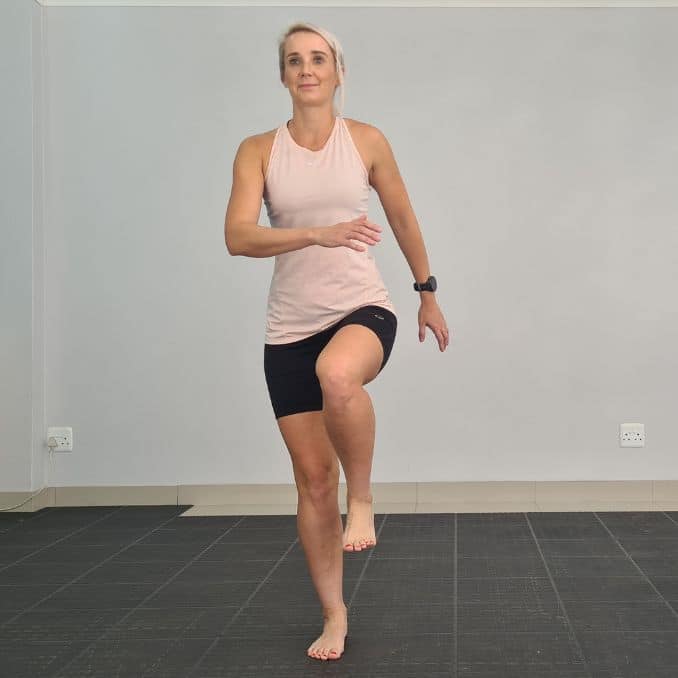 |
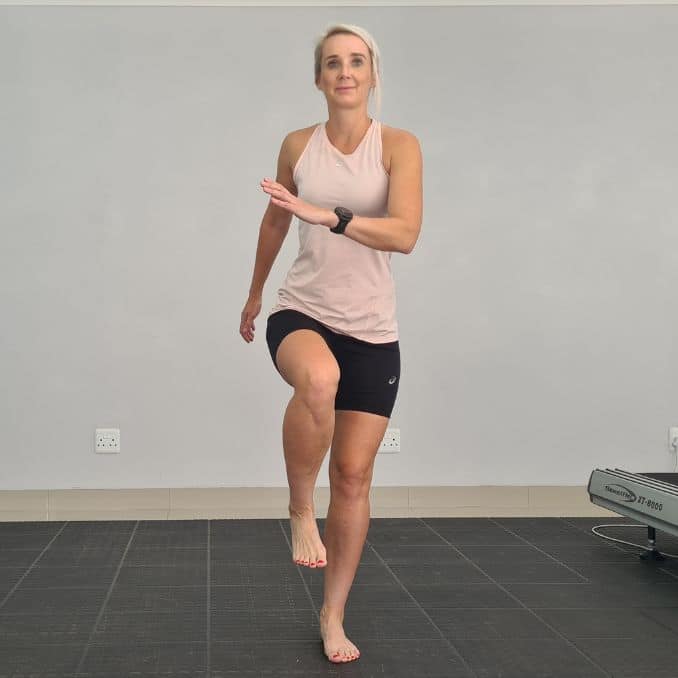 |
Lateral Hops
2. Plié Squats
Begin in an upright standing position with your feet considerably wider than your shoulder width apart, maintaining good alignment with your head, shoulders, and hips. Place your hands on your hips and tighten your abdominal muscles. Bend your knees and hinge through your hips to lower your seat into a deep squat, keeping your knees behind your toes. Raise back up to an upright standing position, squeezing your glutes at the top. Repeat the movement. Start off with 1 set of 10 repetitions.
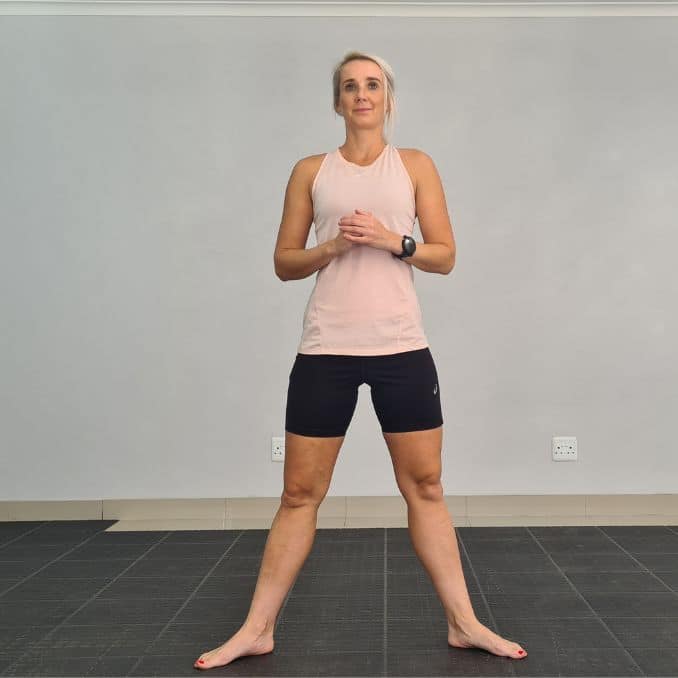 |
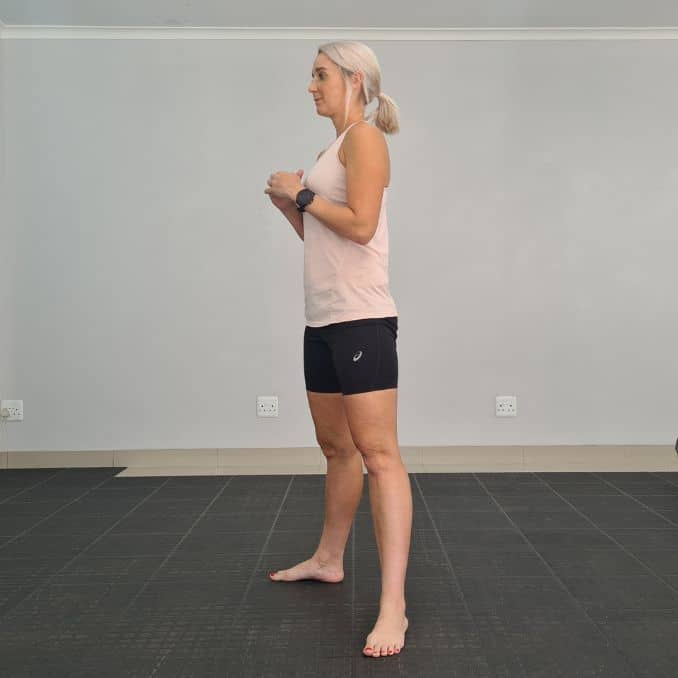 |
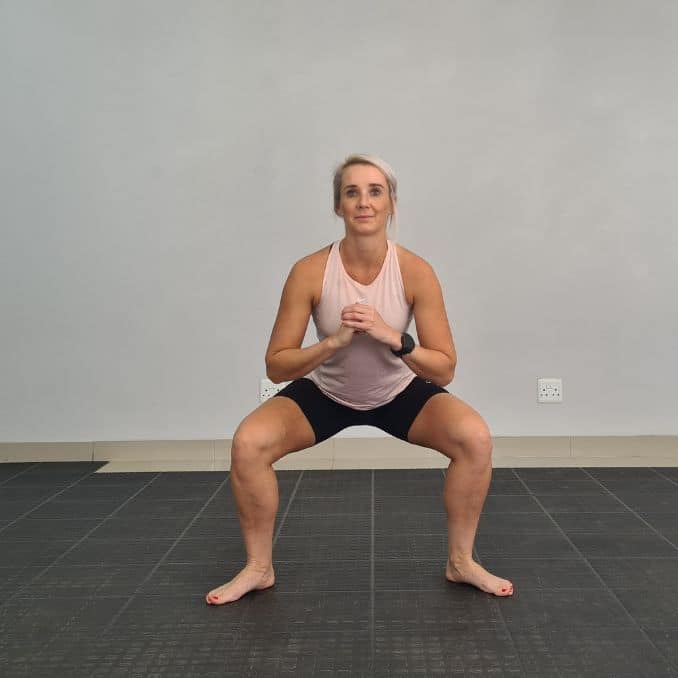 |
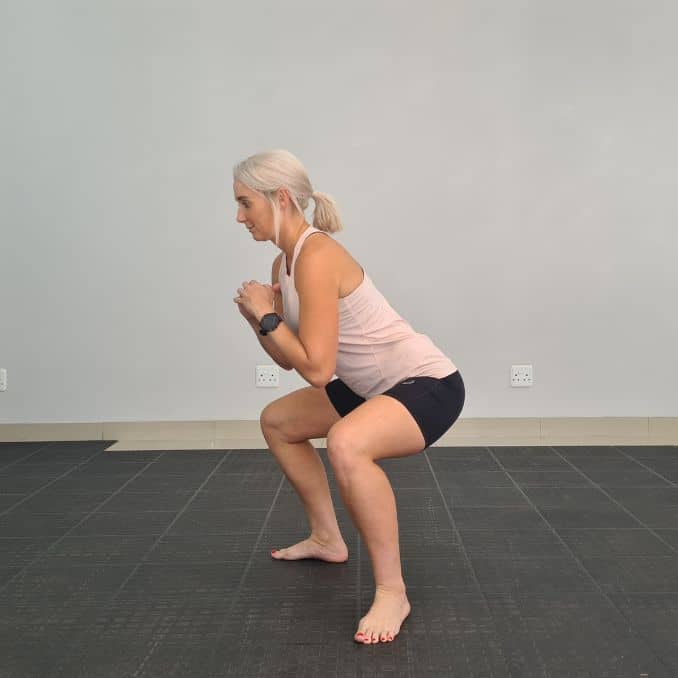 |
Plié Squats
3. High Knees
Begin in an upright standing position with your feet shoulder-width apart, maintaining good alignment with your head, shoulders, hips, and legs. Bring your hands in front of your body at hip-height with your palms facing downward. Engage your core. Lift one knee up towards your chest, touching your bent knee with your hand. Return to the starting position and repeat the movement on the opposite side. Start with 1 set of 5 repetitions on each side.
To make the exercise more challenging, run in place as you lift your knee.
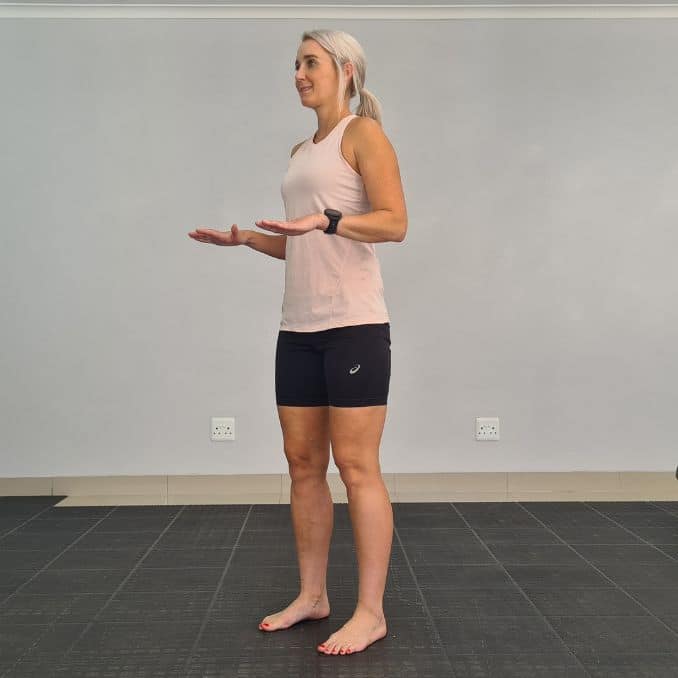 |
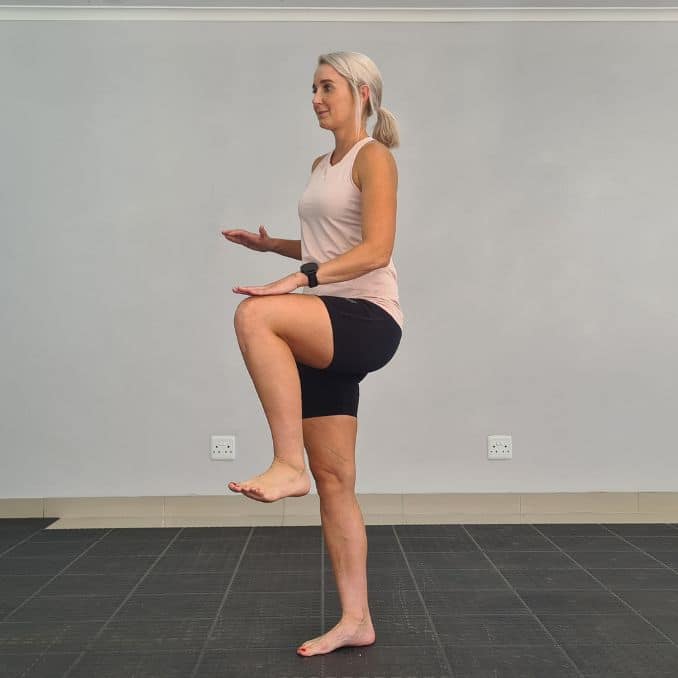 |
High Knees
4. Lateral Fly
Begin in an upright standing position with your legs shoulder-width apart, maintaining good alignment with your head, shoulders, hips, and legs. Bring your hands in front of your body and hinge through your hips to bend your upper body forward. Engage your core and open your arms out to the sides, squeezing your shoulder blades together. Lower your arms to return to the starting position and repeat the movement. Repeat the movement for 10 repetitions.
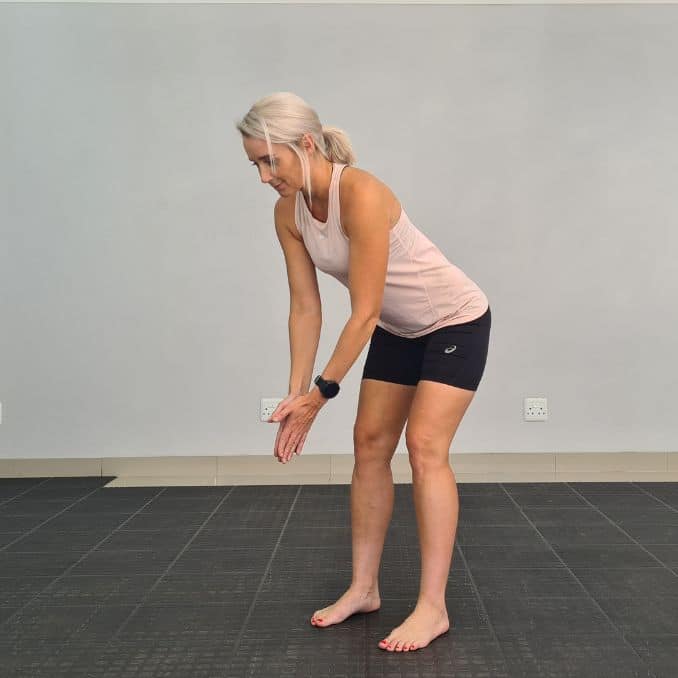 |
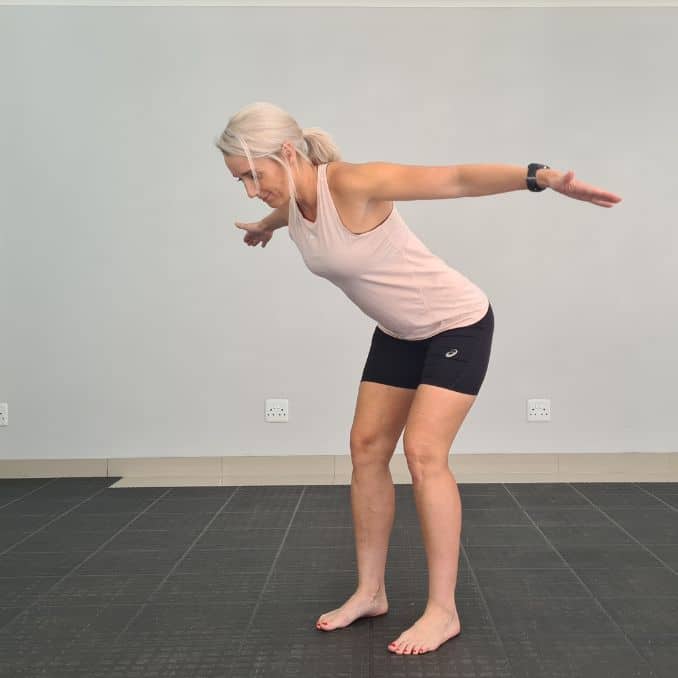 |
Lateral Fly
5. Arm Raises with Toe Tap
Begin in an upright standing position with your legs shoulder-width apart, maintaining good alignment with your head, shoulders, hips, and legs. Engage your core and raise both arms overhead as you tap your one foot back. Return to the starting position and repeat the movement on the opposite leg. Complete 10 repetitions on each side.
To make the exercise more challenging, you can add a jumping movement.
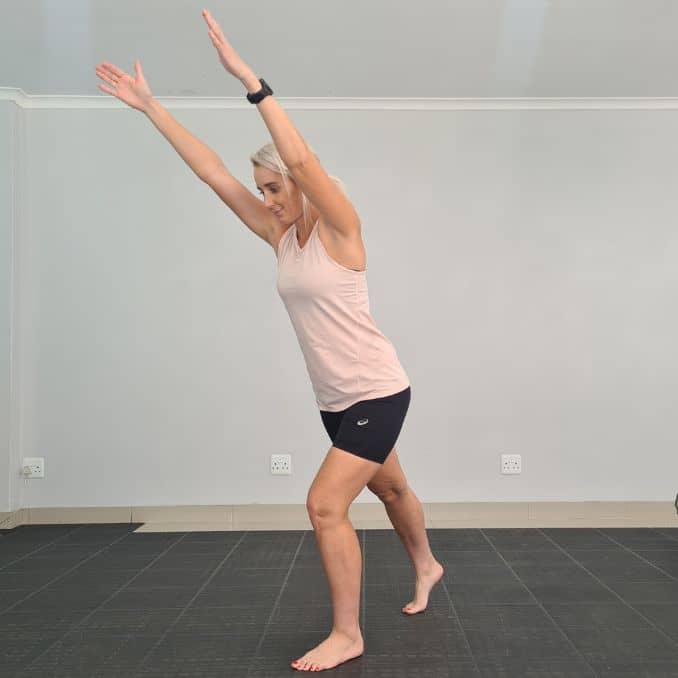 |
 |
Arm Raises with Toe Tap
6. Crunches
Lie on your back with your knees bent and your feet flat on the floor. Interlace your fingers behind your head or place your hands by your ears, maintaining good alignment with your head, shoulders, hips, and knees. Contract your core muscles to roll your upper body forward. Lower your upper body to the starting position. Repeat the movement for 10 repetitions.
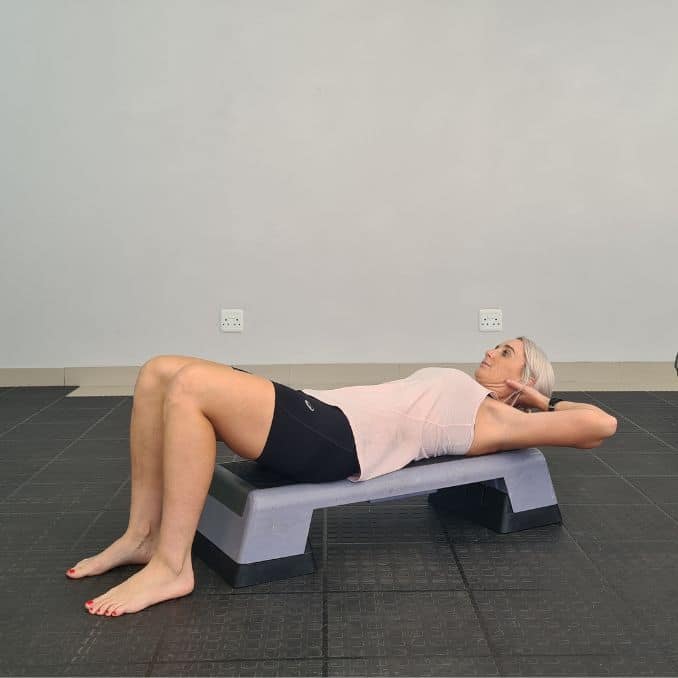 |
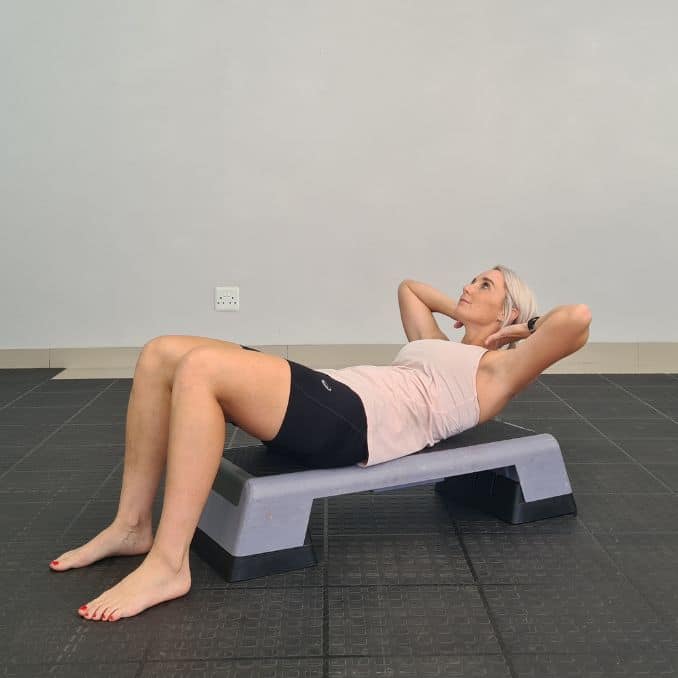 |
Crunches
Cool Downs:
Cool-down exercises are an important part of any exercise routine. Cooling down after a workout helps to reduce the amount of lactic acid buildup in the muscles, which can cause soreness and stiffness. Cooling down also helps gradually reduce your heart and breathing rate, allowing your body to return to its pre-exercise state faster.
1. Side Stretch
Begin in an upright standing position with your feet slightly wider than shoulder-width apart, maintaining good alignment with your head, shoulders, and hips. Extend your hands overhead. Engage your core and bend your upper body to the side. Hold the position for a couple of seconds. Relax and repeat the movement on the opposite side.
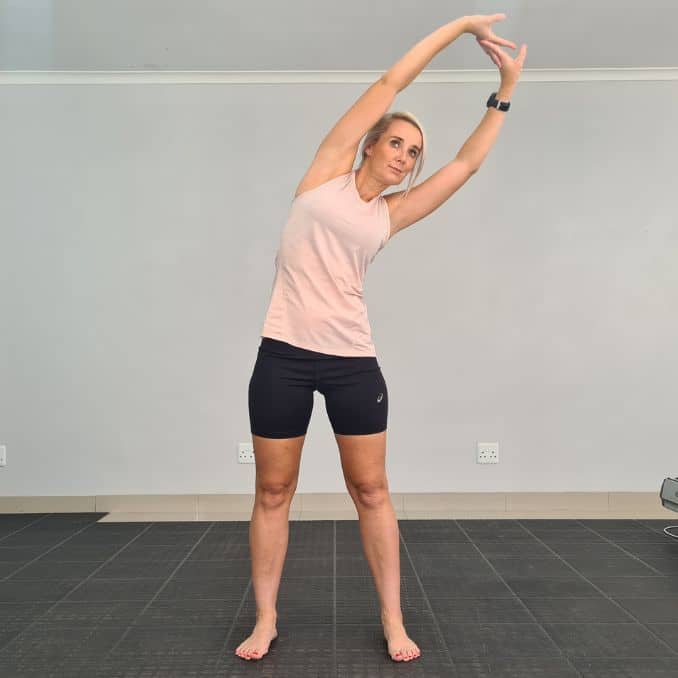
Side Stretch
2. Standing Cat-Cow
Begin in an upright standing position with your feet hip-width apart, maintaining good alignment with your head, shoulders, hips, and legs. Engage your core and hinge through your hips to move your upper body forward. Place your hands on your knees. Slowly round your mid-back as you bow your head down. Alternate by lifting your head and arching your mid-back. Repeat the movement, alternating directions.
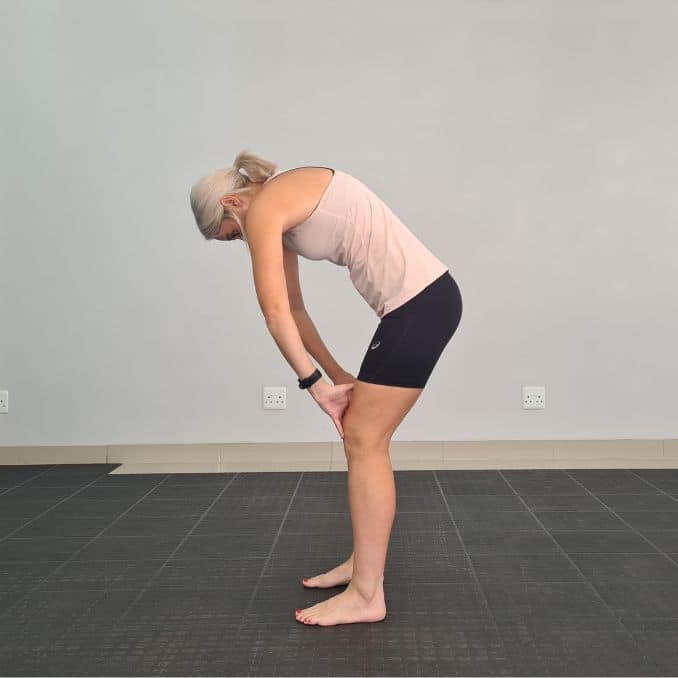 |
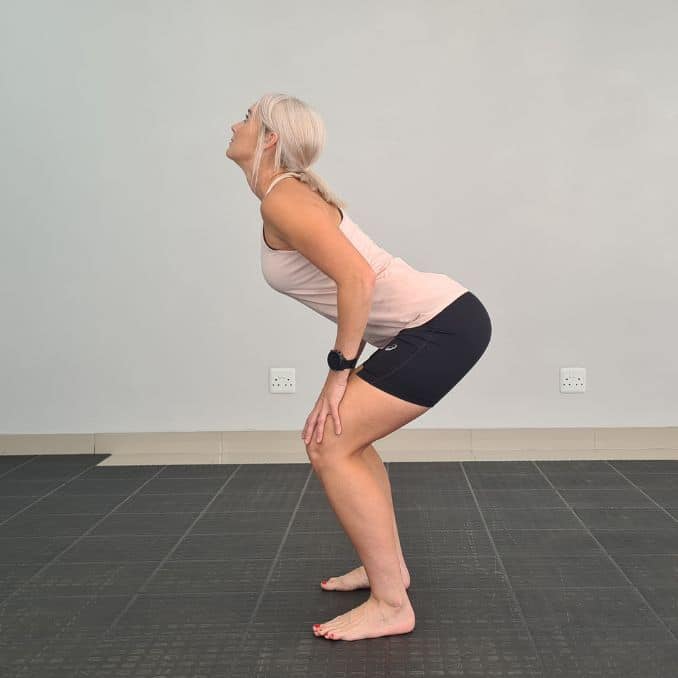 |
Standing Cat-Cow
3. Quad Stretch
For this stretch, you can utilize a wall, a chair, or a countertop for balance if needed.
Begin in an upright standing position with your feet hip-width apart, maintaining good alignment with your head, shoulders, hips, and legs. Place one hand against the wall for balance. Engage your core and bring one heel against your seat, holding your foot with your other hand. Hold this position for a couple of seconds. Return to the starting position and repeat the movement on the opposite leg.
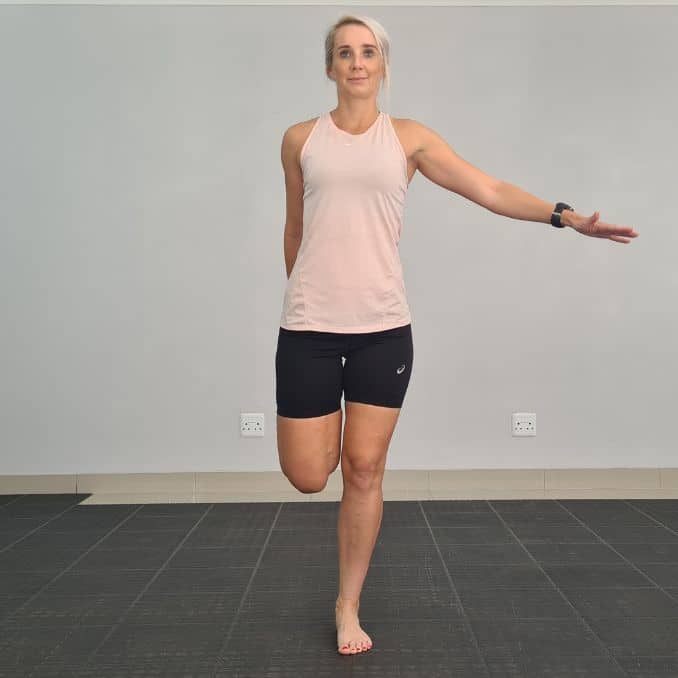
Quad Stretch
4. Forward Fold
Begin in an upright standing position with your feet hip-width apart, maintaining good alignment with your head, shoulders, hips, and legs. Tighten your core and hinge through your hips to bend your upper body forward. Slowly lower your head and arms to reach for your toes while keeping your knees soft. Hold this position for several deep belly breaths, in through your nose and out through your mouth. Relax and return to an upright standing position.
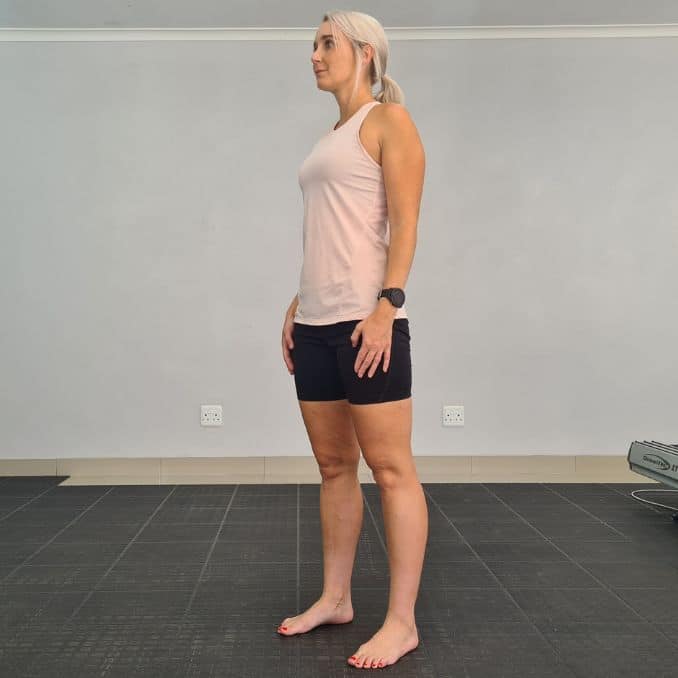 |
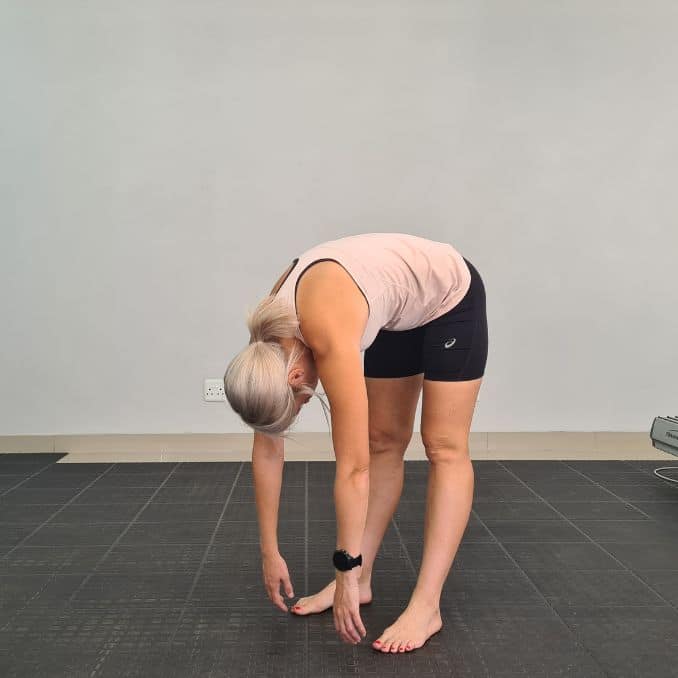 |
Forward Fold
What does exercise do for your heart?
Regular exercise is beneficial for the heart in many ways. Cardio exercises, such as brisk walking or running, can strengthen the heart and improve blood flow throughout the body, reducing the risk of heart disease and heart failure. Exercise also helps improve blood vessels' function, lowering blood pressure and reducing the risk of heart attack and stroke.
Additionally, weight training and balance exercises can help to improve overall cardiovascular health and reduce the risk of falls. In contrast, flexibility and balance exercises can improve mobility and reduce the risk of injury. Incorporating various exercises into your exercise program to achieve optimal heart health benefits is important.
Types of Exercise That Can Improve Heart Rate
1. Aerobic Exercise
Aerobic exercise is one of the best exercises for heart health, which involves using large muscle groups to increase your heart rate and breathing and is especially best for improving heart health. This exercise involves rhythmic, repetitive movements that use large muscle groups and increase heart rate and breathing. Aerobic exercise includes brisk walks, jogging, cycling, swimming, dancing, and jumping rope.
2. High-Intensity Interval Training (HIIT)
HIIT involves alternating high-intensity exercise periods with rest or lower-intensity exercise. This type of workout can improve heart rate and cardiovascular health faster than steady-state exercise.
3. Resistance Training
Resistance training involves using weights or resistance bands to build strength and endurance. This exercise can also help effectively reduce the risk of heart disease and high blood pressure.
4. Circuit Training
Circuit training involves performing a series of exercises, typically with a little rest in between. This type of workout can include cardio and strength exercises, which can improve heart rate and cardiovascular health.
5. Sports
Playing sports such as soccer, basketball, tennis, or hockey can be a fun way to improve heart rate and cardiovascular health. Sports involve a combination of aerobic and anaerobic exercises, which can help build endurance, strength, and overall fitness.
How To Combat Heart-Related Diseases?
Heart-related diseases can be combated through various lifestyle changes and habits. Here are some tips to consider:
1. Be aware of your family history
If you have a family history of heart-related diseases, you are more likely to develop them. It is essential to know your family’s medical history and inform your doctor about it. Your doctor can help you create a personalized plan to reduce your risk of developing these conditions.
2. Take care of your overall health
Eating a healthy diet and maintaining a healthy weight can help lower the risk of heart disease. Avoid foods high in saturated fats and trans fat, cholesterol, and sodium. Instead, eat more fruits, vegetables, whole grains, and lean proteins. Avoid smoking and limit your alcohol intake.
3. Use a fitness tracker
A fitness tracker can help you monitor your daily activity levels and encourage you to be more active. Aim for at least 150 minutes of moderate-intensity or 75 minutes of vigorous exercise each week. This can be broken down into 30 minutes a day, five days a week.
4. Avoid binge-watching
Sitting for long periods of time can increase your risk of heart disease. Try to break up prolonged periods of sitting with short bouts of activity, such as taking a short walk or doing some light stretching.
5. Follow the “good rule” for a healthy heart
This rule includes getting enough sleep (7-8 hours a night), managing stress, and staying connected with loved ones. Poor sleep and chronic stress can increase your risk of heart disease, so taking care of your mental health and seeking support if needed is essential.
Conclusion:
Maintaining a good heart rate is crucial for overall health and well-being. Regular cardio and heart-healthy exercise can help improve heart rate and reduce the risk of heart disease. It’s important to start slowly and work up to a target heart rate zone that is safe and effective for you. The American Heart Association recommends at least 150 minutes of moderate-intensity weekly exercise to maintain a healthy heart. Research shows regular exercise can help manage high blood sugar levels and improve overall health.
By prioritizing heart health through lifestyle changes, you can reduce your risk of developing heart-related diseases and promote a healthy heart. Always consult your doctor before starting any new exercise or dietary regimen.

